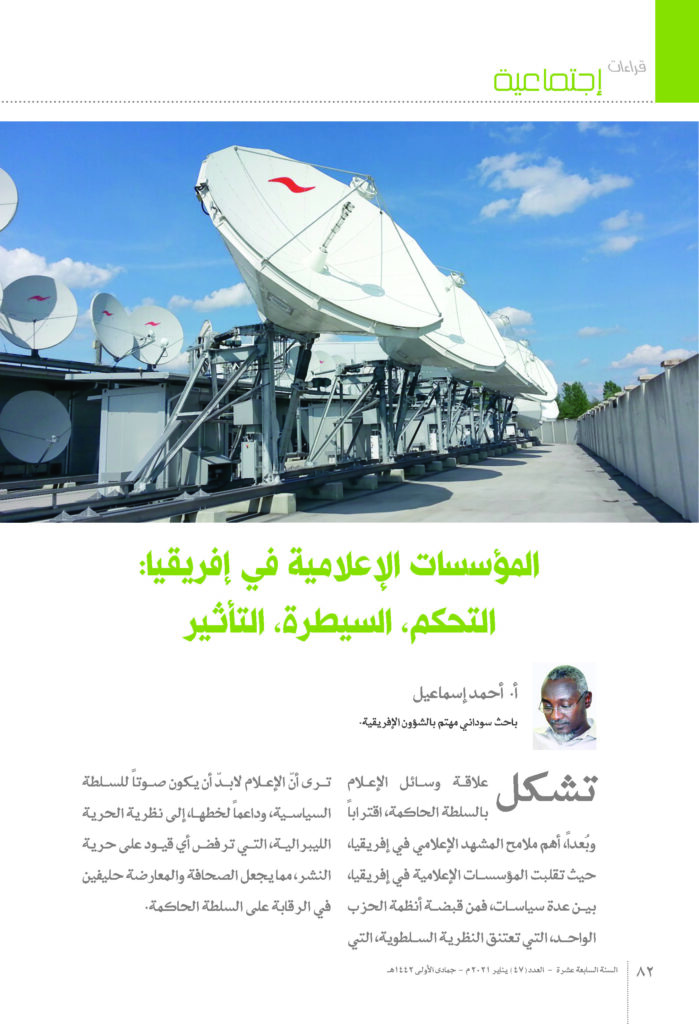Publisher: Qira’at Afriqiyah Magazine
Issue: 47, January 2021
ISSN: 2634-131X
Year : 17
Pages: 82-97
Author: Ahmed Mohammed Ahmed Ismail
Download pdf

Abstract:
The media's relationship with the ruling authority, both close and far, is the most important feature of Africa's media landscape, which determines the space of freedom, where it’s moves, and governs the development of its institutions. The African media was born into European colonialism and, under its auspices, the colonial administration owned the first media institutions and allowed the private institutions of two types of owners, namely white settlers and Christian missions, which were working to achieve the interests of the colonial administration. When the national press later emerged, it made a significant contribution to the national liberation movement that led Africa towards political independence, and most of the leaders of national liberation, who became leaders of the new independent nations in the continent, such as Jomo Kenyatta, Julius Nyerere, Kwame Nkruomah, Nnamdi Azikiwe and Leopold Senghor, came out. But in many African countries, the national government itself turned into an iron fist, restricting the media and forcing it to follow its direction, and this was linked to the space of political freedom in those countries, where the one-party system prevailed for a long time in most African countries, and those regimes were believe that the media has one role to; preach their achievements, and support their political will, so they have dominated its institutions, by owning and acquiring at times, with legislation and legal restrictions at times, censorship, and the imposition of fees and taxes other, but nevertheless, the media in that period lived the growth of integration The tendency to unite in regional entities. At the end of the 1980s and early 1990s, old dictatorships began to crumble, giving way to political pluralism, and the African media played a major role in lobbying for such a transformation alongside other civic forces, a transformation in which its institutions enjoyed a great deal of freedom, unprecedented prosperity and spectacular vertical growth. This was helped by the revolution of infomedia, and the new media, which dominated the world in the decades that followed, and changed the features and structures of media institutions alike, but nevertheless the laws governing the media have not evolved much, but remained a restriction on the freedom of the press, which continues to be a disturbing concern for journalists, where they are constantly subjected to imprisonment, kidnapping, murder because of their opinions and publishing, and despite these dangers, they reflect the strength of the influence of the African media. Africa is experiencing an international media competition for it, which is part of the struggle to extend political and economic influence, as the media is considered an important entry point for access to interests in this race. In addition to the cultural dependency on which countries with colonial heritage relied in Africa, and the information that they control its flow, funding was one of the means of controlling African media, at the institutional level, or at the level of individuals working in the press. As for the influence of media institutions, the nature of the audience and the development environment in Africa has been the ruling factor in the evolution of the types of media institutions. Because of the spread of illiteracy and poor infrastructure, radio has become the most widespread medium in Africa, especially in rural areas, where illiteracy is high, the electricity supply is decreasing, while the print press and television are finding their luck in urban areas. The revolution in communication technology and infomedia has opened great outlets for the future for media institutions, and the spread of the Internet, and the strong use of mobile phones in Africa, greatly supported the transformation of traditional media, to the new media.
